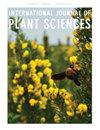Bidens wailele (Asteraceae: Coreopsideae): A New Critically Endangered Species from Kauai, Hawaiian Islands
IF 1.5
3区 生物学
Q3 PLANT SCIENCES
引用次数: 0
Abstract
Premise of research. The explosive diversification of Hawaiian Bidens is considered one of the premier examples of plant adaptive radiation in the native Hawaiian flora. Botanical exploration, especially in remote areas, continues and sometimes results in the discovery of new species. Most of these new discoveries are narrowly distributed endemics, and some are evaluated to be threatened or endangered, sometimes critically so, as is the case for Bidens wailele. Methodology. Bidens wailele K.R. Wood & Knope (Asteraceae/Compositae) is (1) described and illustrated from Kauai, Hawaiian Islands; we also (2) provide a diagnostic key distinguishing characters that separate B. wailele from all other native Kauai Bidens, (3) present a summary of its distribution, ecology, and threats; and (4) provide a formal Red List assessment utilizing the International Union for Conservation of Nature (IUCN) criteria for endangerment. This discovery is part of ongoing floristic research and exploration conducted by the National Tropical Botanical Garden Science and Conservation Department. Pivotal results. This new species occurs in extremely wet conditions around the waterfalls of Waialeale and Wainiha, central Kauai. Morphologically, it is most similar to Bidens valida, a Kauai endemic species naturally occurring around windswept ridges and cliffs of southeastern Kauai (as on Haupu, Hulua, and Kahili Mountains). Conclusions. This rare new species is presently known from only 700–800 individuals and restricted to three remote locations; B. wailele has been evaluated under the IUCN Red List criteria and proposed as critically endangered. A fourth population on a wet cliff where the new species historically occurred (i.e., Kamanu, Kauai) was destroyed by a landslide after its discovery in 2008, most likely caused by torrential rains and demonstrating the species’ vulnerability for extinction.夏威夷考艾岛一种极危新种
研究的前提。夏威夷拜登的爆炸性多样化被认为是夏威夷本土植物区系中植物适应性辐射的主要例子之一。植物探索,特别是在偏远地区,仍在继续,有时还会发现新物种。这些新发现的大多数都是分布狭窄的地方病,其中一些被评估为受到威胁或濒临灭绝,有时甚至是严重的,就像拜登白鼬的情况一样。方法。(1)夏威夷考艾岛的Bidens wailele K.R. Wood & Knope(菊科/菊科);我们还(2)提供了一个诊断关键的区别特征,将白颊拜登与所有其他本地考艾岛的白颊拜登分开;(3)总结了它的分布、生态和威胁;(4)利用国际自然保护联盟(IUCN)的濒危标准,提供正式的红色名录评估。这一发现是国家热带植物园科学与保护部正在进行的植物区系研究和探索的一部分。关键的结果。这种新物种出现在考艾岛中部的怀阿莱勒瀑布和怀尼哈瀑布周围极其潮湿的环境中。在形态上,它与考艾岛特有物种Bidens valida最相似,Bidens valida自然生长在考艾岛东南部(如Haupu, Hulua和Kahili山脉)的风吹山脊和悬崖周围。结论。这种罕见的新物种目前已知只有700-800只,并且仅限于三个偏远的地方;白须鲸已根据世界自然保护联盟红色名录标准进行评估,并被提议为极度濒危物种。第四个种群位于新物种历史上出现的潮湿悬崖上(即考艾岛的卡马努岛),在2008年被发现后被山体滑坡摧毁,很可能是由暴雨造成的,这表明了该物种濒临灭绝的脆弱性。
本文章由计算机程序翻译,如有差异,请以英文原文为准。
求助全文
约1分钟内获得全文
求助全文
来源期刊
CiteScore
4.50
自引率
4.30%
发文量
65
审稿时长
6-12 weeks
期刊介绍:
The International Journal of Plant Sciences has a distinguished history of publishing research in the plant sciences since 1875. IJPS presents high quality, original, peer-reviewed research from laboratories around the world in all areas of the plant sciences. Topics covered range from genetics and genomics, developmental and cell biology, biochemistry and physiology, to morphology and anatomy, systematics, evolution, paleobotany, plant-microbe interactions, and ecology. IJPS does NOT publish papers on agriculture or crop improvement. In addition to full-length research papers, IJPS publishes review articles, including the open access Coulter Reviews, rapid communications, and perspectives. IJPS welcomes contributions that present evaluations and new perspectives on areas of current interest in plant biology. IJPS publishes nine issues per year and regularly features special issues on topics of particular interest, including new and exciting research originally presented at major botanical conferences.

 求助内容:
求助内容: 应助结果提醒方式:
应助结果提醒方式:


